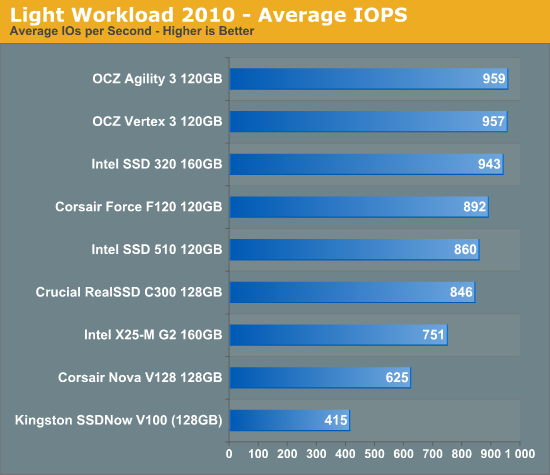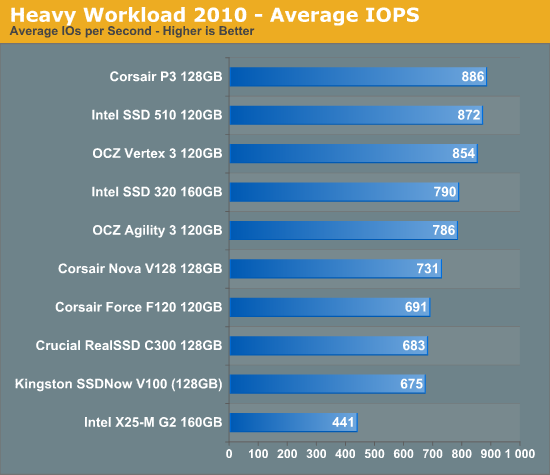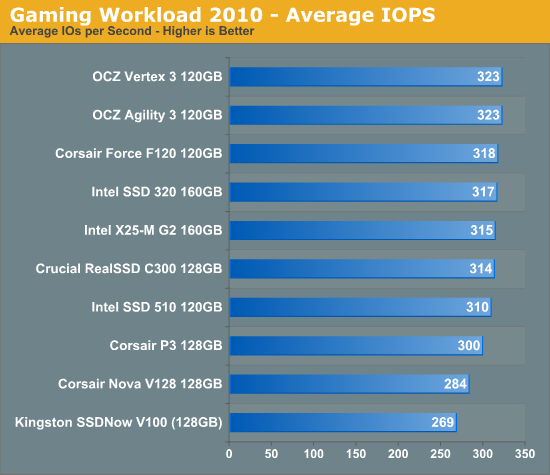The 2011 Mid-Range SSD Roundup: 120GB Agility 3, Intel 510 and More Compared
by Anand Lal Shimpi on June 7, 2011 12:52 PM ESTAnandTech Storage Bench 2010
To keep things consistent we've also included our older Storage Bench. Note that the old storage test system doesn't have a SATA 6Gbps controller, so we only have one result for the 6Gbps drives.
The first in our benchmark suite is a light/typical usage case. The Windows 7 system is loaded with Firefox, Office 2007 and Adobe Reader among other applications. With Firefox we browse web pages like Facebook, AnandTech, Digg and other sites. Outlook is also running and we use it to check emails, create and send a message with a PDF attachment. Adobe Reader is used to view some PDFs. Excel 2007 is used to create a spreadsheet, graphs and save the document. The same goes for Word 2007. We open and step through a presentation in PowerPoint 2007 received as an email attachment before saving it to the desktop. Finally we watch a bit of a Firefly episode in Windows Media Player 11.
There’s some level of multitasking going on here but it’s not unreasonable by any means. Generally the application tasks proceed linearly, with the exception of things like web browsing which may happen in between one of the other tasks.
The recording is played back on all of our drives here today. Remember that we’re isolating disk performance, all we’re doing is playing back every single disk access that happened in that ~5 minute period of usage. The light workload is composed of 37,501 reads and 20,268 writes. Over 30% of the IOs are 4KB, 11% are 16KB, 22% are 32KB and approximately 13% are 64KB in size. Less than 30% of the operations are absolutely sequential in nature. Average queue depth is 6.09 IOs.
The performance results are reported in average I/O Operations per Second (IOPS):

Our old light workload from 2010 highlights an important point about all of these SSDs. For light usage, in a completely IO bound workload, there's only a 13% difference in performance between the fastest 6Gbps drive and last year's C300. If there's only a 13% difference in this completely IO bound test, the real world difference will surely be nonexistent.
If there’s a light usage case there’s bound to be a heavy one. In this test we have Microsoft Security Essentials running in the background with real time virus scanning enabled. We also perform a quick scan in the middle of the test. Firefox, Outlook, Excel, Word and Powerpoint are all used the same as they were in the light test. We add Photoshop CS4 to the mix, opening a bunch of 12MP images, editing them, then saving them as highly compressed JPGs for web publishing. Windows 7’s picture viewer is used to view a bunch of pictures on the hard drive. We use 7-zip to create and extract .7z archives. Downloading is also prominently featured in our heavy test; we download large files from the Internet during portions of the benchmark, as well as use uTorrent to grab a couple of torrents. Some of the applications in use are installed during the benchmark, Windows updates are also installed. Towards the end of the test we launch World of Warcraft, play for a few minutes, then delete the folder. This test also takes into account all of the disk accesses that happen while the OS is booting.
The benchmark is 22 minutes long and it consists of 128,895 read operations and 72,411 write operations. Roughly 44% of all IOs were sequential. Approximately 30% of all accesses were 4KB in size, 12% were 16KB in size, 14% were 32KB and 20% were 64KB. Average queue depth was 3.59.

Our heavy workload is really no different in terms of the performance spread. All of the newer drives show very similar performance.
The gaming workload is made up of 75,206 read operations and only 4,592 write operations. Only 20% of the accesses are 4KB in size, nearly 40% are 64KB and 20% are 32KB. A whopping 69% of the IOs are sequential, meaning this is predominantly a sequential read benchmark. The average queue depth is 7.76 IOs.











68 Comments
View All Comments
JasonInofuentes - Tuesday, June 7, 2011 - link
"It's funny how little the recommendations have changed over the years. Intel still offers a good balance of performance and reliability, however if you're willing to take a risk on the reliability front you can get better value elsewhere."http://www.anandtech.com/show/2738
scook9 - Tuesday, June 7, 2011 - link
Looks good. I recently got a 160GB Intel 320 drive for my M18x but since it has Sata 6Gbps I am going to be pretty tempted to trade up to a 510 down the road. Just could not get excited over that $$/GB for nowStargrazer - Tuesday, June 7, 2011 - link
Awesome. Thanks.(first (non-french) comparison of current-gen ~128GB SSDs I've seen)
apexjr - Tuesday, June 7, 2011 - link
Anand,Thank you for this! This is exactly what I have been waiting for.
dhanson8652 - Tuesday, June 7, 2011 - link
The chart labels on page 5 are conflicting with both charts being labeled read/write write/read with the inverse white on orange text being correct and the black on orange text being incorrect.Anand Lal Shimpi - Tuesday, June 7, 2011 - link
Fixed :)Oxford Guy - Thursday, June 9, 2011 - link
240 GB Vertex 2 at some point... prettie please?You talk about the 240 GB drives offering best case performance. Don't you think people would like to know how good the performance of the 240 GB Vertex 2 is in comparison with 120 GB next-gen units like these?
apexjr - Tuesday, June 7, 2011 - link
For me this article gives weight to the research I have done and the hours reading and analyzing other reviews.For the laptop I had chose the Intel 510 because it has the least power draw idle, 6 Gbps and a proven track record of reliability.
For my gaming machine I had chose the Vertex 3 240gb. Even with the reliability issues that might happen I have nightly backups running (Easy to setup with Windows 7) and spare drives to swap in should something happen.
Confusador - Tuesday, June 7, 2011 - link
One of the things that's held me back from getting an SSD is that I always have at least 2 OSes installed, and a common data partition. Can anyone point me at info on how these drives handle that? I can't find anywhere that Anand has covered it in his roundups. I'd like to know how it affects performance, but what I'm really concerned about is drive life, if the partitioning interferes with the controller's ability to optimize wear leveling.cgeorgescu - Tuesday, June 7, 2011 - link
It's amazing how a Corsair Force F120 (or some Vertex2) still manages to not be beaten that hard by these new arrivals. In pure benchmarks, the new drives have some impressive results but, as long as we're speaking about real-life scenarios, F120 suddenly appears in the graph not far under the new drives.